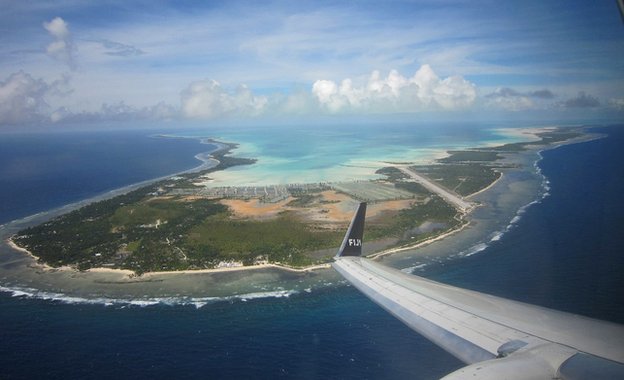Kiribati: Tiny island's struggle with overpopulation

The Pacific island chain of Kiribati is one of the most densely settled places on Earth. The BBC’s Julian Siddle investigates how the island is dealing with its overpopulation problem.
Kiribati is perhaps best known as one of the countries most likely to disappear due to climate change.
Most people who live on Kiribati’s main island - South Tarawa - rely on the surrounding seas for their livelihoods.
The ocean is also the greatest threat to their future survival: No land on this island sits more than 2m (6ft 6in) above sea level, so rising seas could prove devastating.
But that’s not the only challenge facing this Pacific nation.
Stretching over 3.5 million sq km (1.35 million sq mi) of the ocean, Kiribati consists of several islands spread across a territory of similar size to India, but most of the population is concentrated on South Tarawa.
This tiny crescent of land is home to around 50,000 people - it’s overcrowded, with a population density similar to Tokyo or Hong Kong.
“We’ve a relatively stable climate at the moment, but a shift in weather patterns, that pushes us into the hurricane belt, that could wipe us out,” Kiribati’s President Anote Tong told the BBC World Service programme Discovery.
He has long campaigned on the international stage to fund the development of Kiribati to help it resist climate change - and to resettle the population elsewhere, should rising seas engulf the islands.
However, while the effects of climate change may seem distant, the impact of so many people concentrated in such a small space is immediate.
The key issues are those facing many developing nations - providing enough food, water and adequate sanitation.
The island can look like a tropical paradise but in other areas, the illusion is broken when the tide goes out
While it does rain here with predicable regularity, tanks needed to collect rain water are in short supply.
Much of the population relies on underground aquifers, a series of natural horizontal channels which fill up with rainwater.
These are located under the widest section of the island at Bonriki, around the airport.
Two related scientific projects are currently looking at ways to ensure this precious water store is protected.
“We’ve put 15 oceanographic instruments around the reef to better understand the wave transformation, measuring wave height, current strength, water level,” says Herve Damlamian, a coastal numerical modeller with the Secretariat of the Pacific Community (SPC).
Local people report that drinking water now tastes increasingly salty. Herve’s project, the Bonriki inundation vulnerability assessment, is trying to assess the risk of flooding: if a king tide (an especially high one) overtops the island, sending waves crashing from one side to another, this could fill the underground system with undrinkable sea water.
On the reserve itself, Peter Sinclair, water resources adviser at the SPC, heads a team measuring the quality of underground drinking water.
“If the seawater came in over the top, it would have an immediate and catastrophic effect, causing salination for 15 months to two years - this could make the water undrinkable,” he says.
However, population pressure is an issue in this discussion too, Mr Sinclair explains.
“As long as we get rainfall, the system will replenish, but the population pressure encroaches on the reserve and also affects the bacterial content in the water - we have contamination from housing, agriculture, from people holding pigs, the sanitation practices,” he says.
“Elsewhere, water is very contaminated, especially where people live over the top of their wells.”
Nearer the islands’ centres of population, the beaches are covered in all manner of waste from litter to excrement.
“When the tide is up, it does look like a paradise. When the tide goes out, you see the horrible degradation because of humans,” says Cliff Julerat, a coastal engineer with the Kiribati ministry of works.
One way to deal with the problems created by increasing populations may be a return to the old way of life, suggests Tabao Awaerika, secretary to Kiribati’s president.
“It’s like taking a step back into our history - but it’s very difficult to do that,” he explains.
“We had this thought of getting people to eat babai, it’s a local food crop like taro, but it takes about four hours to cook. Breadfruit is about an hour - rice is easier to cook, nicer and cheaper. So why do it?
“We need a total change of mindset. To encourage sustainable activity on outer islands so they don’t need to come to Tarawa.”
However, persuading more people not to come could be difficult.
Artan Rajit, the deputy mayor of nearby Abaiang - a greener, more spacious island with a population of under 10,000 - says simply: “We want what they have in Tarawa.”
For people enduring a near subsistence lifestyle on Kiribati’s outer islands, accepting the overcrowding and polluted environment seems a worthwhile price to pay for the vibrancy of South Tarawa, with its few shops, access to imported food, tinned meat and rice and medical centres.
Despite the pot-holed road and decrepit vehicles, there is also the potential for paid employment - though only around 20% of the population have full-time, paid jobs.
You can return to the main Market News page, or press the Back button on your browser.

